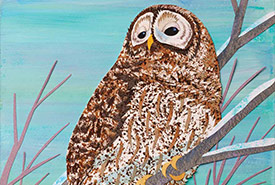Night owls

Barred owl (Illustration by Ashley Barron)
By Megan Quinn, NCC coordinator of conservation biology for eastern Ontario
I am not a morning person. To emphasize that point, I’m writing this Close Encounters at midnight, when I really should be in bed. However, one thing I’ve learned from my work with the Nature Conservancy of Canada (NCC) is that nature won’t wait while I sleep. One cold January morning, I found myself walking beneath the old-growth eastern white pine trees at NCC’s Gillies Grove Nature Reserve in Arnprior, Ontario. Winter had firmly set in. A light dusting of snow covered the trail, and I was glad to be dressed warmly for my day of field work. A limited number of daylight hours forced me to start my hike just as the sun was rising. The forest was quiet. I was the only human out that morning, but despite the silence, I certainly wasn’t alone in the forest. I don’t know what made me look up, but as I turned my head toward the trees, a ghostly shape drifted past. It would be easy to assume the rising sun was playing tricks with my eyes, but this phantom was just as real as me. It was a barred owl.
This large, stocky bird is easily identified by its mottled body, dark eyes and yellow beak, but that morning all I saw was a bright silhouette. Barred owls can be found in mature forests with a mix of coniferous and deciduous trees — like those found at Gillies Grove. They are skilled hunters, often hunting at dawn and dusk. They perch in trees before swooping low into the forest to catch their prey (typically small mammals like mice, squirrels and rabbits). Unless you’ve been lucky enough to witness it, it’s hard to describe how remarkably silent barred owls are when they fly. Like most owls, their feathers are incredibly soft, with a unique shape that means they make almost no noise while in the air. If I wasn’t looking at the exact right time on that day, I would have missed it. The barred owl got its breakfast, and I moved quickly on to let it eat in peace. As I continued my hike, I smiled. From one night owl to another, it was a privilege to witness this majestic creature ending its day, just as mine was starting.
This story originally appeared in the winter 2022 issue of the Nature Conservancy of Canada Magazine. To learn more about how you can receive the magazine, click here.
Explore additional content from our winter issue here >



